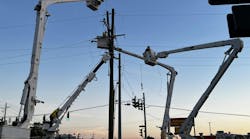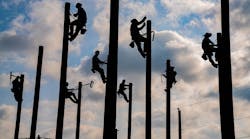It will come as no surprise to electric utility linemen that line work can be a dangerous job. Case in point: more than 300 fatalities and 3,500 injuries stem from workplace electrical incidents each year, according to the Electric Safety Foundation International. The majority of these electrical-related deaths are caused by contact with overhead power lines, followed by contact with wiring, transformers or other electrical equipment.
To keep their field workforce safe, utilities are training their linemen and investing in the latest personal protective equipment. In honor of National Electric Safety Month, here are seven strategies you can use to help your fellow brothers and sisters to go home safely at the end of each work day.
1. Practice accident response. Injuries can happen when linemen least expect it, and when a coworker gets hurt on the job, linemen must be able to spring into action quickly. To test their linemen’s response times in an emergency, some utilities are setting up mock incidents.
These simulated scenarios can unfold in a variety of ways. For example, at a conference last fall, one utility shared its story about how a lineman in a bucket was asked to lie down out of sight. Meanwhile, a manager covertly timed and videotaped the crew members’ response to the fallen lineman. At Avista, the utility set up an elaborate simulated scenario involving the field crew as well as dispatchers, the police and rescue teams (page 64J).
2. Ask for help. Electric utilities are often facing the same challenges in the field day in and day out. Rather than reinventing the wheel, many companies are joining forces to tackle these issues. For example, linemen from around the world can attend a day-and-a-half-long safety conference in conjunction with the International Lineman’s Expo each fall. In addition, many of the country’s electric utility managers attend the annual Transmission & Distribution Maintenance Management conference, where they can participate in interactive forums, swap ideas for safety practices and learn from industry experts.
3. Work with safety-minded contractors. As utilities are faced with an increased workload and fewer resources, many are turning to line contractors to help to rebuild power lines or repair aging infrastructure. When the contractors come to work on a utility’s system, their linemen often attend the same safety training, wear the same personal protective equipment and follow the same safety procedures as the linemen working for the utility.
Some line contractors, however, are taking their commitment to safety a step further. Ten years ago, contractors created the Electrical Transmission & Distribution Partnership. By identifying areas of concern, establishing best practices and training their field workforce, some contractors now have better safety rates than some utilities for which they do work.
4. Wear flame-retardant (FR) clothing. Long ago, linemen’s FR garments were hot and stiff, but that is no longer the case. Manufacturers are now designing shirts, pants and outerwear that keep linemen dry and comfortable and also protect them from arc flash hazards. In this month’s product section, we are featuring the latest FR clothing (page 64O). And in Parting Shot (page 64P), a lineman from Salt River Project wears the long-sleeved FR shirt and pants required by his utility when working near energized conductors.
5. Keep your trucks stocked with emergency supplies. While many electric utility linemen may keep the basic first aid equipment in their line trucks, chances are that not all work vehicles are equipped with an automatic external defibrillator. On a remote jobsite, however, an automatic external defibrillator can save the life of a lineman, as was the case with Salt River Project, which now requires all of its trucks to carry this device.
6. Invest in fall protection. Harnesses can take time to get accustomed to and can slow down pole climbing. As such, utilities’ safety departments often face resistance when they try to mandate that linemen wear fall protection devices in the field. To get buy-in from the crews, many utilities are engaging linemen in the product-selection process, offering a variety of choices when it comes to harnesses and training apprentices to use them from the start.
7. Train your field workforce. When it comes to safety, utilities are training both their apprentices and veteran field managers how to work safely. In the utility industry, technology moves at a rapid pace, and everyone, from the young apprentices to the linemen nearing retirement, needs to be aware of changes in a utility’s safety practices and personal protective equipment. Otherwise, even the most seasoned lineman can be at risk for an injury or fatality.
Editor’s note: To view a full report of statistics about electrical-related injuries and fatalities from the U.S. Bureau of Labor Statistics and ESFI, visit www.esfi.org and click on Workplace Safety. Also, to learn more about the Electrical Transmission & Distribution Partnership, visit www.powerlinesafety.org.


